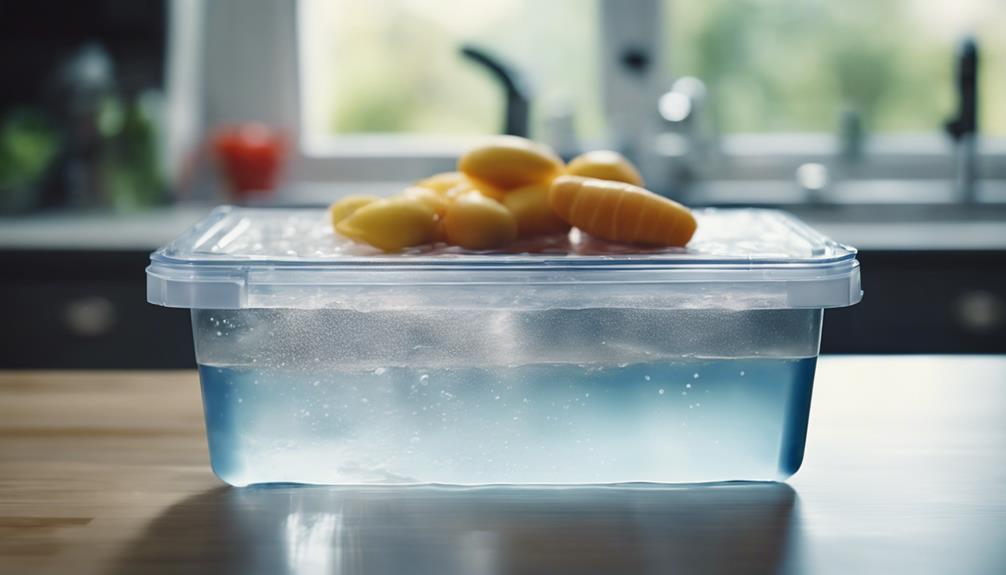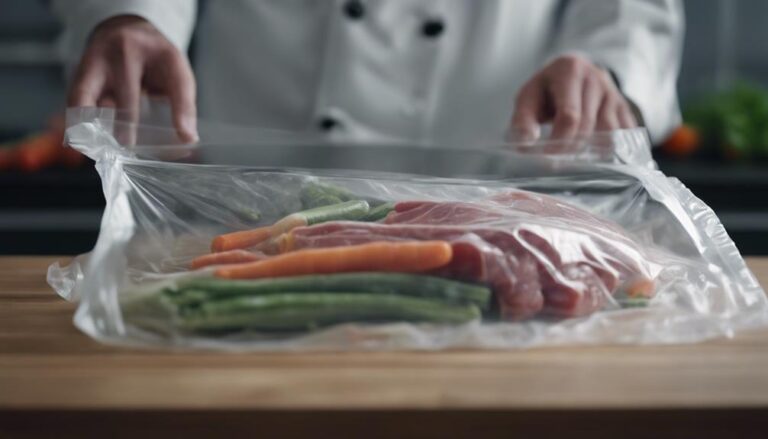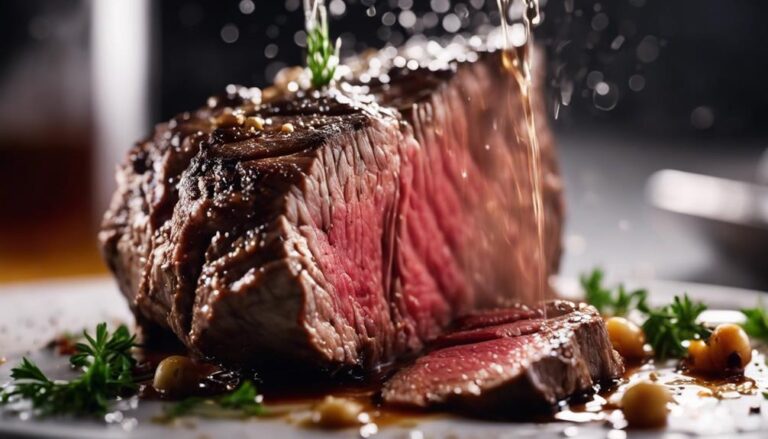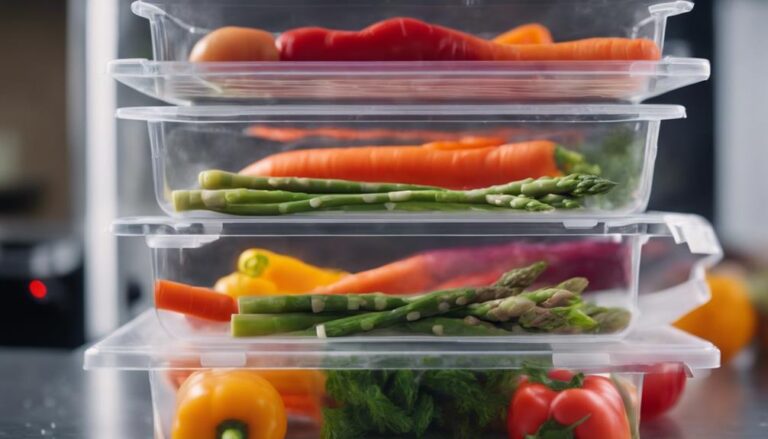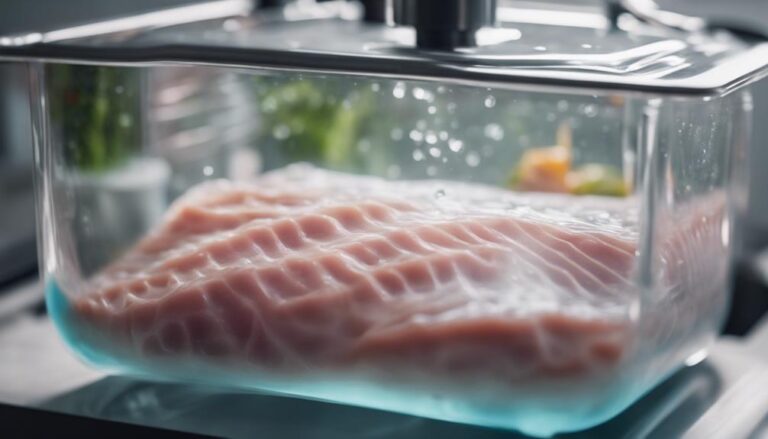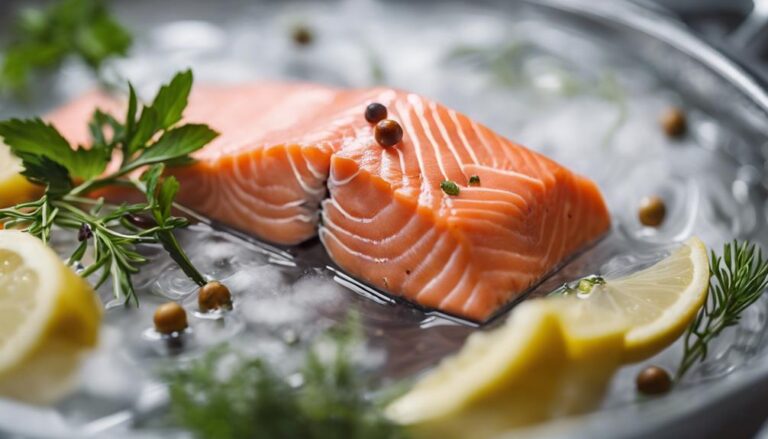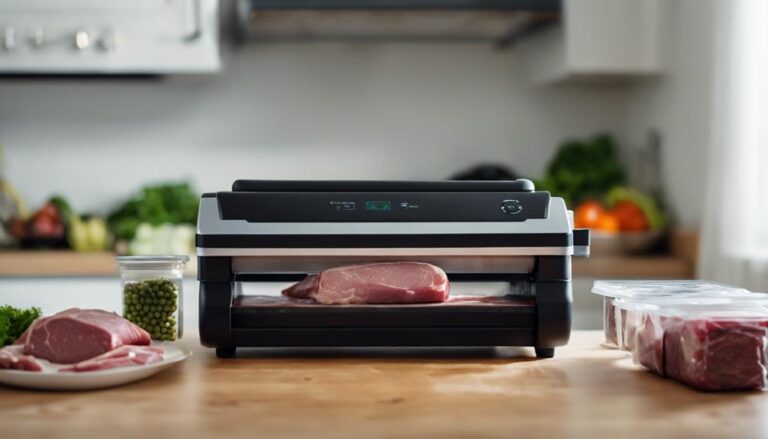Sous Vide Water Bath Basics: Everything You Need to Know
To master sous vide water bath cooking, you need an immersion circulator and a heat-resistant container with proper water level. Temperature control is essential for perfect doneness. Try searing your food for enhanced flavor. Experiment with flavor infusion using herbs and spices. Preserve nutrients by cooking vegetables sous vide. Look into brands like Oliso and Instant Pot for versatile cookers. Explore DIY hacks with coolers or rice cookers. Packaging options like vacuum sealing bags are handy. Consider getting insulated containers and racks to level up your sous vide game. Get ready to elevate your dishes to new heights with these basics!
What You Will Learn Here
- Water bath maintains precise temperature for even cooking.
- Ensure full submersion of food for consistent results.
- Use lid to retain water temperature and prevent evaporation.
- Proper water level is essential for efficient heat transfer.
- Reliable immersion circulator ensures accurate temperature control.
Equipment for Sous Vide Water Bath
To set up your sous vide water bath properly, you'll need an immersion circulator for precise temperature control. This device ensures that the water bath maintains a consistent temperature throughout the cooking process, allowing your food to cook evenly. When selecting an immersion circulator, look for one that's reliable and easy to use, as it will be the heart of your sous vide setup.
The water bath itself should be a heat-resistant container that's deep enough to fully submerge the food you plan to cook. This container should also have a lid to help retain water temperature and prevent unnecessary evaporation. Ensuring that the water level is essential for proper circulation and cooking efficiency in your sous vide setup.
Importance of Precise Temperature Control
You know that precise temperature control is the cornerstone of successful sous vide cooking. Consistency in heat distribution throughout the water bath is crucial for achieving the perfect doneness in your dishes.
Maintaining accuracy in temperature settings will guarantee that your food turns out just the way you desire.
Temperature Accuracy Is Key
Ensuring precise temperature control in your sous vide water bath is essential for achieving consistent and accurate cooking results. Even a slight temperature fluctuation of 1-2°F can greatly impact the doneness and texture of your food.
Invest in a high-quality sous vide immersion circulator like the Anova Precision Cooker, which offers accuracy within 0.1°F to guarantee ideal cooking outcomes. Maintaining a constant and precise water temperature is critical for proteins to coagulate properly and delicate foods to be cooked gently.
Consistent Heat Distribution Essential
Maintain consistent heat distribution in your sous vide water bath to guarantee precise temperature control for perfectly cooked food every time.
The water bath, acting as a thermal conductor, plays an essential role in evenly cooking your meals. Proper insulation of the water bath is necessary to create a stable cooking environment, ensuring consistent results.
By keeping the water bath temperature within a narrow range, you can achieve the exact doneness you desire without the risk of overcooking or undercooking.
Paying attention to the heat distribution in your water bath is important for the success of your sous vide cooking endeavors. Trusting in the precise temperature control provided by your well-maintained water bath will elevate your culinary creations to new levels of excellence.
Achieving Perfect Doneness
Precision in temperature control is paramount for achieving perfect doneness in sous vide cooking. Maintaining the water bath temperature within a degree or two of the desired cooking temperature is essential.
Even minor temperature fluctuations can greatly impact the texture and doneness of your food, underscoring the importance of accurate water bath temperature. Consistent water temperature throughout the cooking process guarantees uniform results, preventing both overcooking and undercooking.
To achieve the ideal texture and doneness in your sous vide-cooked dishes, precise temperature control is key. Investing in a reliable sous vide machine with accurate temperature monitoring capabilities is vital for consistently achieving perfect results across various types of food.
Searing Techniques in Sous Vide Cooking
When searing in sous vide cooking, you'll be enhancing the flavor profiles of your dishes by creating a delicious crust. By perfecting the sear, you'll achieve a Maillard reaction that adds depth and complexity to your food.
Different searing techniques like using a hot skillet or torch can elevate both the taste and presentation of your sous vide-cooked meals.
Perfecting the Sear
To achieve a perfect sear when finishing sous vide-cooked meats, start by patting the food dry to enhance browning and flavor.
Make sure the pan is preheated on high heat and use high smoke point oil, like avocado or grapeseed oil, for a successful sear.
Once the pan is hot, sear the meat for a short time on each side. This process helps develop a caramelized crust without overcooking the interior.
After searing, allow the meat to rest. Resting is essential as it lets the juices redistribute, resulting in a final dish that's juicy and tender.
These steps won't only enhance the visual appeal of your dish but also elevate its flavors for a delightful dining experience.
Enhancing Flavor Profiles
For an elevated culinary experience, mastering searing techniques after sous vide is essential to revealing a world of rich flavors and textures in your dishes. Searing creates a flavorful crust on the food through the Maillard reaction, which adds complexity and depth to your dish. This process not only enhances the flavor but also locks in juices, contributing to a perfect texture that complements the tenderness achieved through sous vide cooking.
Flavor Infusion Methods

Enhance your sous vide dishes by infusing flavors through the addition of herbs, spices, and aromatics directly into the food bag. When preparing your ingredients for sous vide cooking, consider vacuum sealing them with your favorite herbs to maximize flavor infusion. The vacuum-sealing process guarantees that the herbs' aromas and tastes infuse thoroughly into the food during the cooking process, resulting in a more flavorful dish.
Popular choices for flavor infusion include citrus zests, garlic, and fresh herbs like rosemary, thyme, and parsley. By incorporating these ingredients into the vacuum-sealed bags, you can enhance the taste and aroma of your proteins or vegetables. This method not only adds depth to the flavors but also helps in tenderizing proteins while infusing them with a rich blend of herbs and spices.
Cooking Categories in Sous Vide
When exploring different cooking categories in sous vide, you'll discover a range of techniques that enhance your culinary skills and bring out the best in various ingredients. Sous vide cooking allows for precise temperature control, ensuring consistent results every time. Vegetables Sous Vide preserves the texture, flavor, and nutrients of carrots, asparagus, and broccoli, making them vibrant and delicious. Eggs Sous Vide guarantees perfectly cooked eggs with a custard-like consistency that will impress your guests. Below is a table showcasing these cooking categories and their benefits:
| Cooking Categories | Benefits |
|---|---|
| Sous Vide Cooking | Salmon stays moist and tender with consistent results. |
| Vegetables Sous Vide | Preserves texture, flavor, and nutrients of carrots, asparagus, and broccoli. |
| Eggs Sous Vide | Ensures perfectly cooked eggs with custard-like consistency every time. |
Experimenting with these categories will enhance your sous vide skills and allow you to serve exceptional dishes to those you care about.
Types of Sous Vide Machines
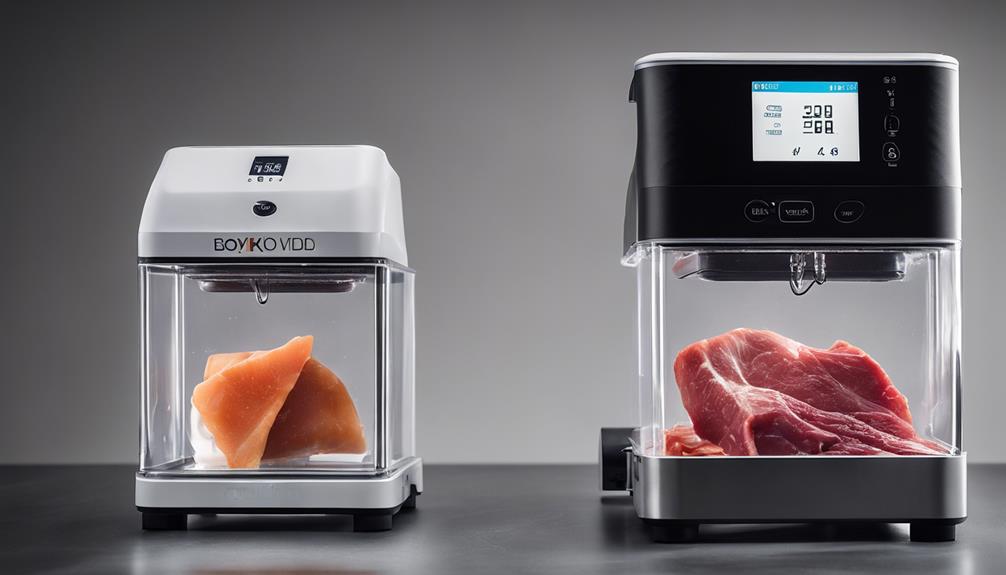
If you're looking to enhance your sous vide cooking game, understanding the different types of sous vide machines available is crucial. Here are some options to explore:
- Sous Vide Immersion Circulator: These standalone devices efficiently heat and circulate water for precise cooking.
- Anova Precision Cooker Options: Choose from a variety of models such as Pro, 3.0, Nano 3.0, and standard options, all crafted for sous vide cooking perfection.
- Sous Vide Water Oven: These fully-contained devices are specifically designed to heat water for sous vide cooking, providing a convenient all-in-one solution.
- Multi-use Cookers: Brands like Oliso, Gourmia, and Instant Pot offer versatile cookers that include sous vide capabilities along with other cooking functions, adding flexibility to your kitchen.
- DIY Sous Vide Hacks: For the adventurous home cook, exploring creative methods like using coolers, rice cookers, or slow cookers can provide a fun way to experiment with sous vide cooking techniques.
DIY Sous Vide Hacks
To explore alternative methods for sous vide cooking at home, consider trying out DIY sous vide hacks using common kitchen tools like coolers, rice cookers, or slow cookers. These hacks provide a cost-effective way to experiment with sous vide cooking without the need for specialized equipment. While not as precise as dedicated sous vide machines, DIY setups can still deliver delicious and tender results when used correctly. By manually controlling the water temperature, you can achieve precise cooking outcomes similar to traditional sous vide methods. Many home cooks find DIY sous vide hacks accessible and practical for their culinary adventures.
| DIY Sous Vide Hacks | Description | Benefits |
|---|---|---|
| Cooler Hack | Insulate water bath with a cooler | Cost-effective alternative |
| Rice Cooker Hack | Use rice cooker to regulate water temperature | Multi-functional kitchen tool |
| Slow Cooker Hack | Utilize slow cooker for sous vide cooking | Convenient for long cooking times |
Packaging for Sous Vide Cooking
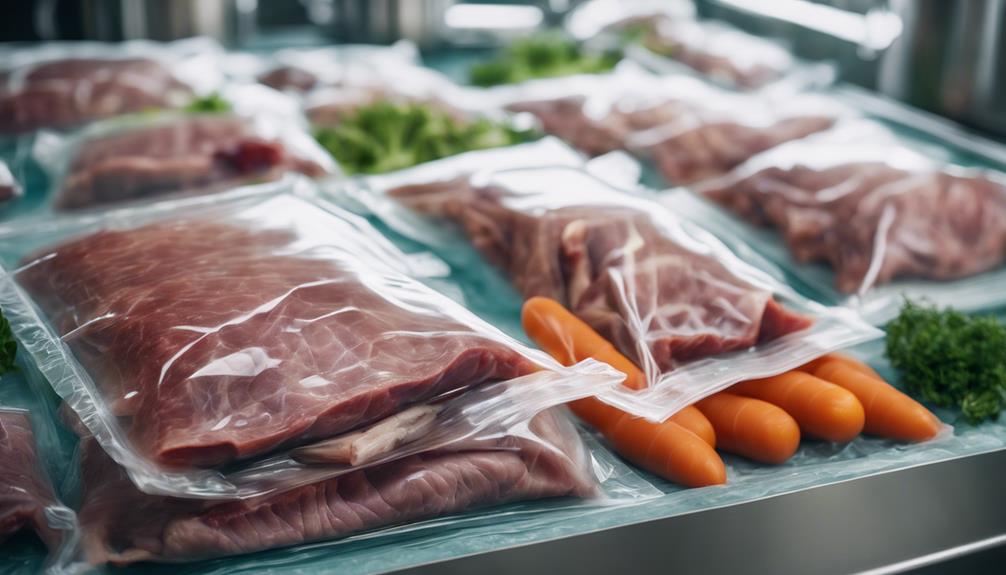
For effective sous vide cooking, select appropriate packaging options to enhance food quality and preservation. When it comes to packaging for sous vide cooking, consider the following options:
- Sous Vide Bags: These specialized bags are designed to withstand the low and consistent temperatures of sous vide cooking, ensuring that your food cooks evenly and retains its flavors.
- Vacuum Sealing Bags: Ideal for batch cooking and long cooks, these bags provide airtight seals that preserve the freshness of your ingredients while enhancing their flavors.
- Reusable Silicone Bags: An eco-friendly option that reduces single-use plastic waste, these bags are durable and can be used multiple times, making them a sustainable choice for sous vide cooking.
- Resealable Bags: Versatile for removing air using the water immersion method, these bags are perfect for maintaining food freshness and preventing any leaks during the cooking process.
- Canning Jars: Suitable for a variety of foods like beans, grains, cakes, and custards, these jars provide airtight storage options that can be easily transferred from sous vide cooking to storage.
Sous Vide Containers and Accessories
Sous vide containers of various sizes are essential for accommodating different food quantities during the cooking process. These containers play a vital role in making sure that your food cooks evenly and thoroughly in the water bath. Additionally, accessories like sous vide racks help to keep food bags submerged, while insulated containers help maintain water temperature for extended cooking durations. Silicone lids are also beneficial as they prevent water evaporation and heat loss, contributing to a more efficient cooking process. Using a sous vide lid with a precision cutout for immersion circulators ensures a secure fit, further optimizing the cooking environment. To give you a better idea, here's a helpful table outlining some essential sous vide containers and accessories:
| Type of Accessory | Description |
|---|---|
| Sous Vide Containers | Available in various sizes to accommodate different food quantities. |
| Sous Vide Racks | Helps keep food bags submerged in the water bath for even cooking. |
| Insulated Containers | Maintain water temperature during long cooking sessions. |
| Silicone Lids | Prevent water evaporation and heat loss for efficient cooking. |
Frequently Asked Questions
How Do You Use a Sous Vide Water Bath?
You simply set your sous vide machine to the desired temperature, fill the container with water, and place your food bags in for precise cooking. Confirm proper water levels, use a lid, and monitor periodically for a flawless culinary experience.
What Temp Should Sous Vide Bath Be?
For perfect sous vide cooking, set your water bath temperature according to the food type: 130-140°F for meats like steak, 120-130°F for delicate fish, 180-185°F for veggies. Follow these best practices for precise results.
What Is the First Thing I Should Sous Vide?
Start with simple meat cuts, like chicken breasts or pork chops, when you sous vide. They provide a great foundation for mastering temperature control and tenderness. Once comfortable, explore vegetables and even dessert options!
What Are the 6 Safety Steps for Sous Vide Cooking?
Guarantee food safety by utilizing food-grade bags, monitoring water bath temperatures, implementing pasteurization, cooling food quickly, and verifying internal temperatures. Maintain equipment for secure cooking to prevent contamination and ensure delightful results.
Conclusion
Now that you know the basics of sous vide water bath cooking, you can elevate your culinary skills with precision and consistency. Experiment with different flavor infusion methods, searing techniques, and cooking categories to create mouthwatering dishes.
Don't be afraid to get creative and try out DIY hacks or different packaging methods. With the right equipment and knowledge, you can become a sous vide master in no time.
Happy cooking!
